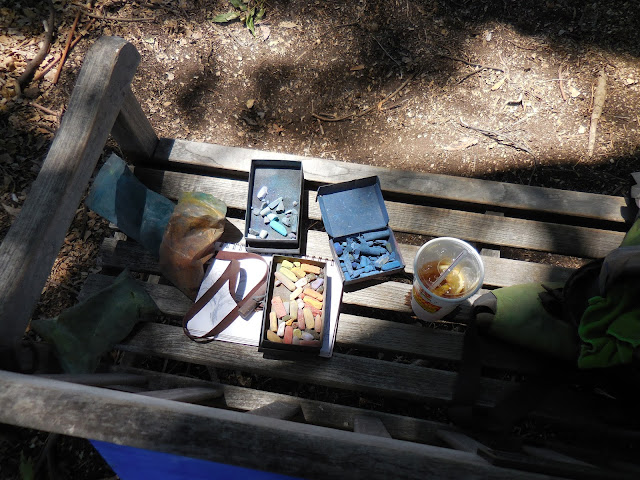I had to deliver my art to the Brea Gallery www.breagallery.com later that day and I wanted to paint. The heat was high so I found some shade. I think the shade was more important than the subject. I love it when I can find a bench or something to put my pastels on; it makes it so much easier.
I like painting on orange boards because they really build the complimentary color relationships that I prefer quickly.
I got the idea of the composition down and established some of the key color relationships in the painting that I would develop further.
The unpainted area in the bottom of the painting would turn into the shadow of the tree I was under. The value contrast between the ground I had already put down seemed right compared to the unpainted part of the board so I left it until I decided what color it was going to be.
The inconsistent lighting on the board is difficult to work with. I like to work in total shade or total light. This makes comparing all of the colors to each other a lot simpler and makes for better choices.
Here I am working to bring the painting back on track. Usually I will go where the painting takes me. Changing the painting because the lighting conditions change is something I am usually good at. It is something I do more than most plein air painters because I am usually working longer than they are. I usually anticipate what the light will be like when I am I will finish and build to that finale.
You can really see the difference in the surface of the painting and the quality of the colors here.
I do like the aerial perspective in the painting and the impressionistic feel to the mark making within the painting. The overall color scheme is good but I had hoped for more. The painting measures 24"X32" and is painted on sanded plywood with acrylic paint and pumice gel.
The detail shot reveals the muted nature of much of the mark making within the painting. I am not a big believer of blending in the traditional sense, but in this painting I used a neutral gray to soften the shadows and the background by making long strokes over the entire surface of those areas. Kind of a deconstructive blending if you will.














No comments:
Post a Comment